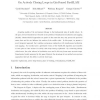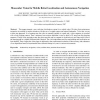AROBOTS
2002
14 years 3 months ago
2002
This paper concerns the exploration of a natural environment by a mobile robot equipped with both a video color camera and a stereo-vision system. We focus on the interest of such ...
ASC
2004
14 years 3 months ago
2004
In this paper, we describe development of a mobile robot which does unsupervised learning for recognizing an environment from action sequences. We call this novel recognition appr...
AI
2004
Springer
14 years 3 months ago
2004
Springer
Over the last years evidence has accumulated that shows the possibility to analyze human brain activity on-line and translate brain states into actions such as selecting a letter ...
TROB
2008
14 years 3 months ago
2008
Abstract--We evaluate a technique that uses an embedded network deployed pervasively throughout an environment to aid robots in navigation. The embedded nodes do not know their abs...
JIRS
2007
14 years 3 months ago
2007
Retaining functionality of a mobile robot in the presence of faults is of particular interest in autonomous robotics. From our experiences in robotics we know that hardware is one ...
AR
2005
14 years 3 months ago
2005
Acquiring models of the environment belongs to the fundamental tasks of mobile robots. In the past, several researchers have focused on the problem of simultaneous localization an...
IJCV
2007
14 years 3 months ago
2007
This paper presents a new real-time localization system for a mobile robot. We show that autonomous navigation is possible in outdoor situation with the use of a single camera and ...
RAS
2006
14 years 3 months ago
2006
We present a fast and efficient homing algorithm based on Fourier transformed panoramic images. By continuously comparing Fourier coefficients calculated from the current view wit...
RAS
2006
14 years 3 months ago
2006
The operation of an autonomous mobile robot in a semi-structured environment is a complex, usually non-linear and partly unpredictable process. Lacking a theory of robot
KES
2006
Springer
14 years 3 months ago
2006
Springer
With the development of service robots and with the emerging concept of the ubiquitous world, localization of a mobile robot has become a popular issue. Even though several localiz...


